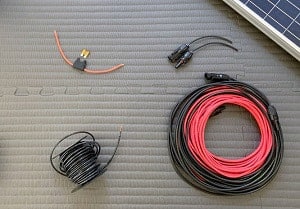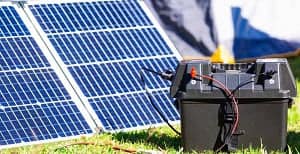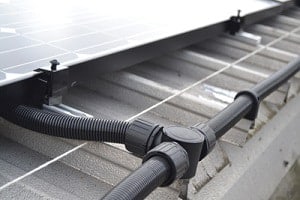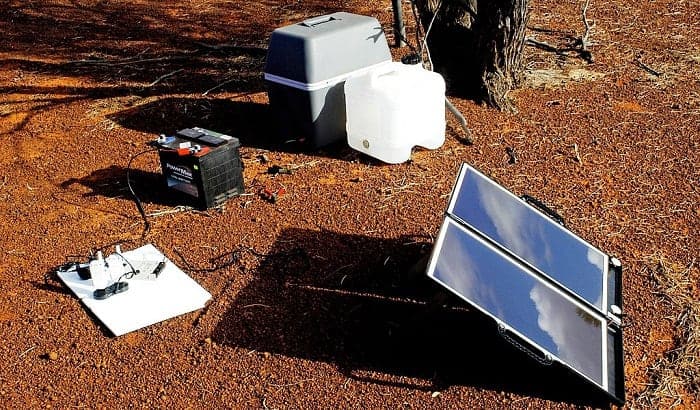
Are you wondering how to connect a solar panel to a 12 volt battery? This is one of the common issues you’ll need to deal with. This won’t be a struggle for you if you’re a professional electrician; however, you’ll need to review some guidelines and instructions if you’re a novice.
In this post, we’ll help you correctly connect your solar panel system to a 12-volt battery. Just install the solar panel, link the battery & the controller, the controller & the panel, then set up the inverter. Read on for more details.
Table of Contents
What are the Required Tools and Materials for Wiring Solar Panels for 12 Volt System
Wire
This is one of the essential items needed to connect the solar panel with other sections, such as the battery.
12 volt solar panel wiring diagram (electrical wiring diagram)
This one is necessary since it’s a circuit diagram that aids you in obtaining a deeper understanding of the required circuitry of your solar panel system. Additionally, it provides you with the wire’s length and size you have to purchase.
AC Breakers and Sub-panels
Sub-panels are needed to connect distinct AC solar panels. On the other hand, AC breakers are necessary for transporting the solar panel system’s AC power. You also have to inspect their compatibility since there could be different circuits for mounting.
Junction Boxes and Slices
The slice boxes and fuses are necessary items because they immensely help enhance the safety and protection of the entire solar panel system. Moreover, the Junction boxes serve a vital role in insulating the energy within the solar modules.
Such materials are necessary to keep handy to complete the wiring process. Since diverse solar panel systems come with different circuits, you’re also required to purchase these items to support the specific voltages and amperage requirements.
Some of these items are utilized indoors, while some are intended for outdoor use. Please note that they should have separate ratings.
EMT & ENT Conduits
This one is usually an essential item for the mounting process. While it’s true that ENT conduits are straightforward to use and less expensive, they’re commonly forbidden to utilize for prevalent building codes.
PV Meters
These tools are required if you prefer to set up a solar panel system that is connected with the grid. Typically, it’s necessary to set up meter sockets to assess the power from the solar array.
Likewise, this device is known for precisely measuring the amount of usable energy your solar panel system is producing. Some PV meters will require an internet connection to make monitoring your solar panel system’s energy production a breeze.
AC Fuses and Disconnects
Such tools are meant for safety purposes. In general, the package list will include a non-fused manual AC disconnect that enables you to evaluate the grid. Meanwhile, the fused manual AC disconnect protects the circuits.
The Process on How to Connect a Solar Panel to a 12 Volt Battery
Here are the detailed steps on how to correctly link a solar panel system to a 12-volt battery:
Before mounting the solar panel and connecting solar panel to battery, please choose the most suitable location to set it up. We highly recommend that you set up the panel system on the roof so that it could get the best sun exposure.
Essentially, this approach can significantly help ensure longer sunlight hours to produce solar energy.
Step 1: Affix the solar panel.
Make sure that the solar panel faces the sun when affixing it.
Step 2: Connect the battery and the controller.
The second step is to link the 12-volt battery’s cable to the charge controller. The solar charge controller is known for being a valuable component for averting overcharging. This component does a great job of interfacing the batteries and the solar panels. Hence, it helps regulate the solar energy from solar panel systems to batteries.
Step 3: Inspect the charge controller.
For this step, you’ll need to check your charge controller. Once your controller is already linked to the 12V battery, turn it on and inspect if it’s working correctly.
There are different solar charge controller options available these days. The more advanced alternatives are usually built with LED signal lights or feature display screens that show the status details and indicate how the device is working.
Meanwhile, if you get the more basic PWM charge controllers, these options are also designed with an indicator light that helps you determine if the device is on and operating. Once you’re done checking if the solar charge controller is working correctly, you can switch it off and proceed to the next step.
Heads Up
Before wiring the solar panel to the battery, please be reminded that you cannot connect the solar panels directly to the battery. First, it’s necessary to link the solar panel to the solar charge controller.
Step 4: Connect the charge controller to the solar panel & the battery to the inverter
Now is the time to wire your charge controller to the solar panel by using the mec4 connector.
Since the solar panel is adept at converting Direct Current electricity, you’ll need to utilize an inverter to charge or operate a device in Alternating Current.
It’s essential to carefully follow the methods of linking your solar panel system to a 12V battery when charging a battery with the aid of the panel. This is particularly beneficial when you need to charge a 12-volt battery with a portable solar panel system or when you’re outdoors.
Then, you may set up the battery that you require after you calculate your daily consumption. Charge your 12-volt battery with a solar panel system and have your backup powered. Remember that it’s vital to connect the solar panels through a regulator.
Lastly, link the regulator to the 12V battery. Nowadays, nearly all regulators come with specific charging profiles for different types of automotive batteries that are usually utilized.
For more information, check out this video on how to connect solar controller with solar panel and battery:
How to Find Suitable Solar Panel Systems for Yourself
For those who don’t own solar panel systems yet, you’re perhaps contemplating what type of solar panel you’ll require. First and foremost, if you want to charge a single 12 V battery, you could practically opt for a single 12V solar system.
Bear in mind that the types of solar panel systems you pick will depend on your preference and requirement; solar panels are designed in different configurations and sizes.
For instance, rigid solar panels are ideal for permanent setups because they’re sturdier and ideal for tolerating inclement weather conditions. On the other hand, foldable solar panels are recommended for homeowners who require a compact and lightweight option.
Let’s check the following options below:
Solar Panel Kits
Buyers who are just starting to use solar panel systems will find solar panel kits user-friendly. This is because the kit contains all the required components for installation. Besides, they are more reasonably priced and come with a user manual for an easier setup process.
It’s more convenient to use solar panel kits because there’s no need to purchase the installation components separately.
300 and 400-Watt Solar Panels
For shoppers operating several 12V solar batteries, these options can provide higher power ratings and greater efficiency that might be the appropriate choices for your requirements.
200-Watt Solar Panels
These alternatives usually contain the stand legs and brackets required for a more straightforward and fast setup process. 200-watt solar panel systems can charge batteries quite fast because they’re designed with highly efficient solar cells.
100 Watt Solar Panels
These options are ideal for users who have basic solar energy requirements. They are comparatively less expensive choices and work outstandingly in low light conditions. In the same way, this type of solar panel is highly recommended for any application.
Typically, 100W solar panel systems are ideal choices for novices searching for dependable alternatives that they could utilize to assemble their solar power system.
Sizing Solar Panels
The most excellent means to figure out the required size of the solar panel is computing the number you get when you multiply the power load of the board with the amount of time your panel gets for capturing the sun’s energy.
Generally speaking, solar panels will have a minimum of four to six hours for charging a 12-volt battery on sunny days. This battery range could provide approximately 12 up to 18 amp current to a deep cycle battery. Hence, you can rely on a 350 ah battery for five hours at the end of an entire sunny day.
Depending on your location and budget, select the highest capacity and most outstanding quality solar panel for charging the batteries.
Final Thoughts
Ultimately, if you’re just getting started using solar power, the most fundamental factor you need to learn more about is how to connect a solar panel to a 12 volt battery. As discussed, a solar panel wired to a basic 12V battery is deemed one of the most manageable solar power systems that you can build.
Once you have understood how to set up one correctly, you’ll be delighted to start harvesting the perks of producing and using your own source of renewable energy.
We hope that the guides shared in this post can help you make the most out of your solar panel systems. Did you find this article informative and interesting? Please share it with others!

I am Kathleen Miller, staff writer and reviewer of the Avasolar team. Working with the team has been a pleasure for me so far, I hope to bring readers useful information by creating detailed and easy-to-follow contents.






